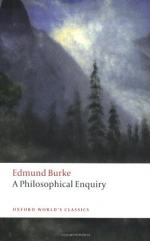
|
| Name: _________________________ | Period: ___________________ |
This quiz consists of 5 multiple choice and 5 short answer questions through Part V.
Multiple Choice Questions
1. How, according to Burke, can light and dark be equal?
(a) If one experiences light and dark for equal periods of time.
(b) Because according to science, there is no difference between light and dark.
(c) When the overpowering nature of one creates the effect of the other.
(d) Only when quantities balance each other.
2. What two main passions connect with this creative power of the mind?
(a) Lust and desire.
(b) Curiosity and understanding.
(c) Love and hate.
(d) Pain and pleasure.
3. What set of animals does Burke use as examples of power and the sublime?
(a) Dogs, cats, and mice.
(b) Birds, fish, and reptiles.
(c) Oxen, bulls, and horses.
(d) Elephants, buffalo, and giraffes.
4. To which scientific finding does Burke compare his study of the beautiful and sublime?
(a) Tycho Brahe's astronomical observations.
(b) Albertus Magnus' alchemical experiments.
(c) Newton's theory of gravity.
(d) Galileo's proof of a heliocentric Earth.
5. How do smells and tastes become sublime most effectively?
(a) When combined with eating and drinking.
(b) When moderated through narrative and description.
(c) When they occur when one is in a dreaming state.
(d) When mediated through art.
Short Answer Questions
1. Which passion belongs under the heading of "self-preservation?"
2. What does Burke assert about sensory observation?
3. Why does Burke include a section on the effect of words in "A Philosophical Enquiry Into the Origin of Our Ideas of the Sublime and Beautiful"?
4. Which is one of the examples Burke cites to demonstrate the sublime in poetry?
5. What does Burke use as an example of difficulty as greatness?
|
This section contains 382 words (approx. 2 pages at 300 words per page) |

|




